Want to attract more birds to your garden? In this post, learn about the best bird feeders to start with as well as tips for effectively installing and maintaining them.
* All photos on this page were taken by me unless otherwise noted. Please provide content and photo credits to thesouthernwildgarden.com.
** The Southern Wild Garden is supported by readers like you! Some links found on this website may be affiliate links, which means I may get a small commission, at no additional cost to you, if you buy a product through one of my links. And as an Amazon Associate, I earn from qualifying purchases through links to Amazon. I only recommend products that I use and love.
Why Feed Birds?
If you’re reading this post, you are probably someone who already appreciates the joy and connection to nature one gets from watching birds. Installing feeders will allow you to observe birds more closely and will likely bring more birds into your garden. But for those folks who stumbled across this article by accident, I’ll let you know that there are numerous scientific studies that show spending time with birds will benefit your mental health and wellbeing. The World’s birds also help keep pests in check, eating over 400 million metric tons of bugs each year. Chickadees will feed their chicks over 6,000 caterpillars before they leave the nest. Hummingbirds may capture up to 2000 small insects, including gnats and mosquitoes, each day when they are feeding young.
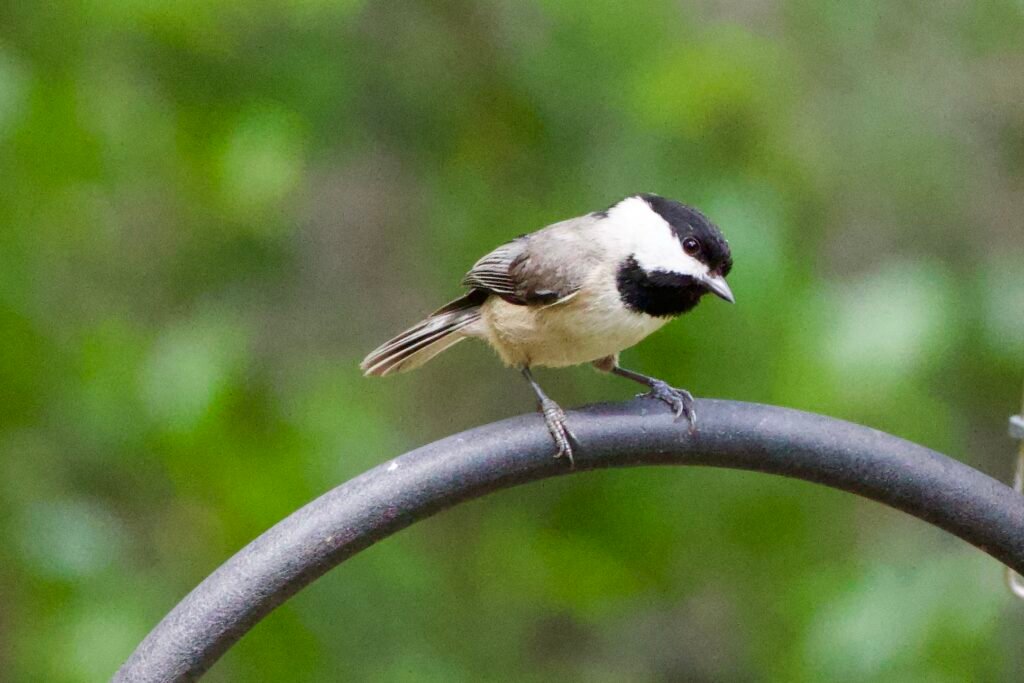
Adding feeders to your garden also benefits bird populations if folks follow a few simple guidelines that I will provide in more detail below. The number of birds in North America has declined by 29% since 1970, that’s about 3 billion fewer birds living today than 50 years ago. Habitat loss, pesticide use, collisions and outdoor cats all contribute to the loss of birds across the world. By providing food and habitat for birds at your home, you will support their ability to survive and raise young.
My Bird Obsession
As an ornithologist for over 20 years, I have spent a lot of time watching and studying birds, From the forests of Chile to the Alaskan tundra to the feeders my folks put up when I was a kid, I have always been enchanted by the birds I’ve been lucky enough to encounter across the globe. Every species is beautiful and unique, singing and nest building and migrating and living their lives the best they can in an ever changing World. My obsession extends to my own garden, where creating a sanctuary for my feathered friends is a passion that hopefully comes across in the articles I write here.
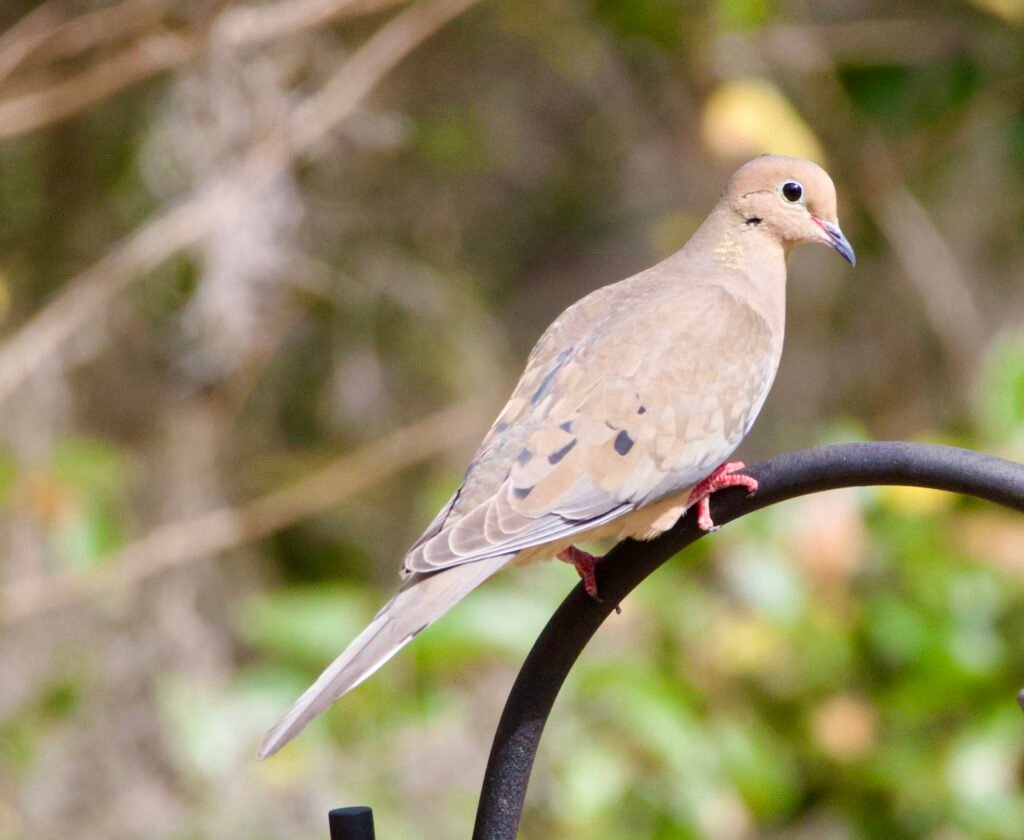
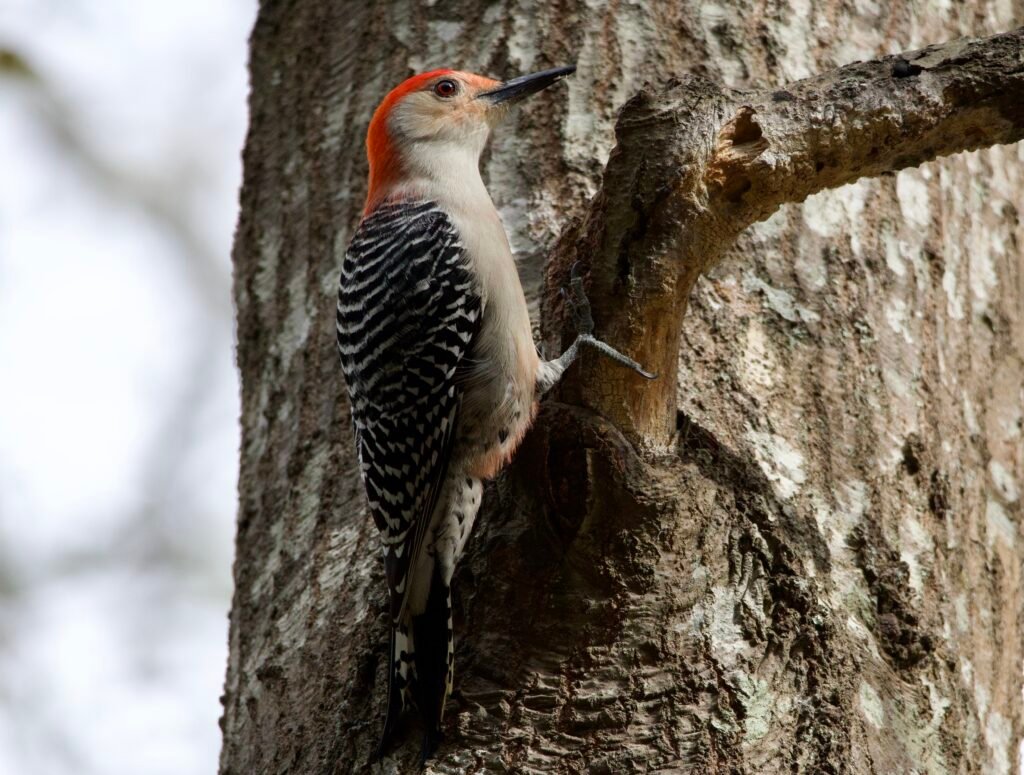
How to Get Started?
The birds that frequent your garden eat a variety of food including seeds, insects, fruits, and nectar. The easiest and most common way to start feeding birds is by providing seed. Seed for birds is readily available online and in stores, as are an overwhelming variety of devices made specifically to offer seed to birds. You would likely have some birds use any feeder you put out if filled with seed intended for wild birds. But, from my experience, starting with the best equipment will prevent you from having to replace a less than ideal setup later. As your interest in birds grows, you will want to add more variety and specialty feeders and food to target specific species or groups of birds. Starting with a feeder system that can be tailored later to meet your needs will save you time and money in the long run.
Location
So, there are a few things you need to consider when designing your bird feeder setup. The first is location. You may want to view your feeder from a particular window so you can watch birds while you work at your desk or wash dishes. Or you may want to enjoy watching birds at your feeder while rocking on the porch. Ensure wherever you place your feeder setup is in a good location for your maximum viewing pleasure.
In addition, for the safety of your birds, you will want to place feeders either within 5 feet or at least 30 feet from windows. Hundreds of millions of birds are killed each year by flying into glass,. Make sure your feeders are placed the correct distance from windows to reduce the chance of collisions. If birds are hitting your windows, consider some options to reduce the problem.
Also, you’ll need to locate feeders far enough from trees, fences, and other structures that may allow unwanted critters to jump to your feeders. Squirrels and raccoons are cute but they will empty and damage your feeders. If you have troublesome black bears in your neighborhood, you will need to make additional adjustments to your feeder set up that are beyond the scope of this article. Proper placement of feeders combined with a baffle will make your feeder safe from all but the most acrobatic of squirrels. Baffles will also prevent other unwanted pests like rats and mice from getting into your feeders. I’ll provide more details about baffles below.
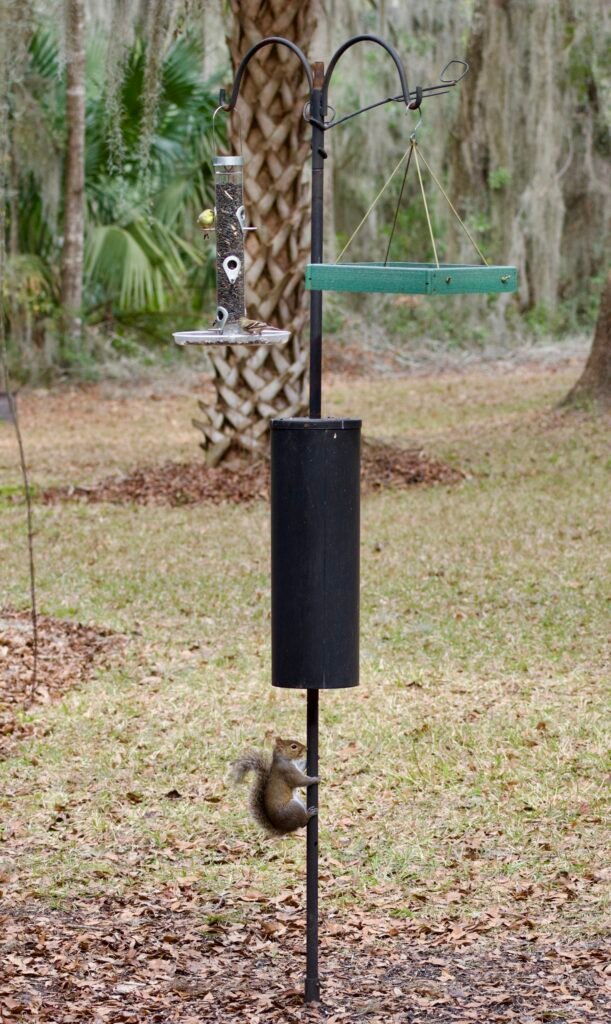
Free-ranging Cats
Outdoor cats are the largest source of direct human-caused mortality for birds in the US, killing billions of birds each year. If you have a lot of free-ranging cats in your area, you may want to consider either not having a bird feeder in your yard or using seed trays to capture a lot of the seed that would otherwise fall on the ground. You do not want to encourage birds to be on the ground in your yard if they will be exposed to predation by cats. The feeder setup I am recommending here is a hanging setup, so birds using the feeders should be safe from cats hunting on the ground.
Disease
Birds carry a variety of diseases, most of which are not communicable to people. It is always a good practice to wash your hands after handling your bird feeders. You should also wash your feeders whenever they appear grimy or if you see any birds in your area that look sick. Sick birds may look lethargic and have difficulty flying, may have body feathers puffed up even in warm weather, and may have crusty eyes and bill. Do not handle sick birds and consider taking down feeders while any sick birds are present. I find I see more birds that look ill during migration in the spring and fall when non resident birds are moving through the area.
In all honesty, washing feeders is not a fun chore, but it is important for the health of your birds. In addition to transmitting disease, dirty feeders may grow mold that is unhealthy for your birds. I recommend buying feeders that are easily taken apart and therefore, easier to clean. I’ll detail the two easy to clean feeders I recommend as potential starter feeders below.
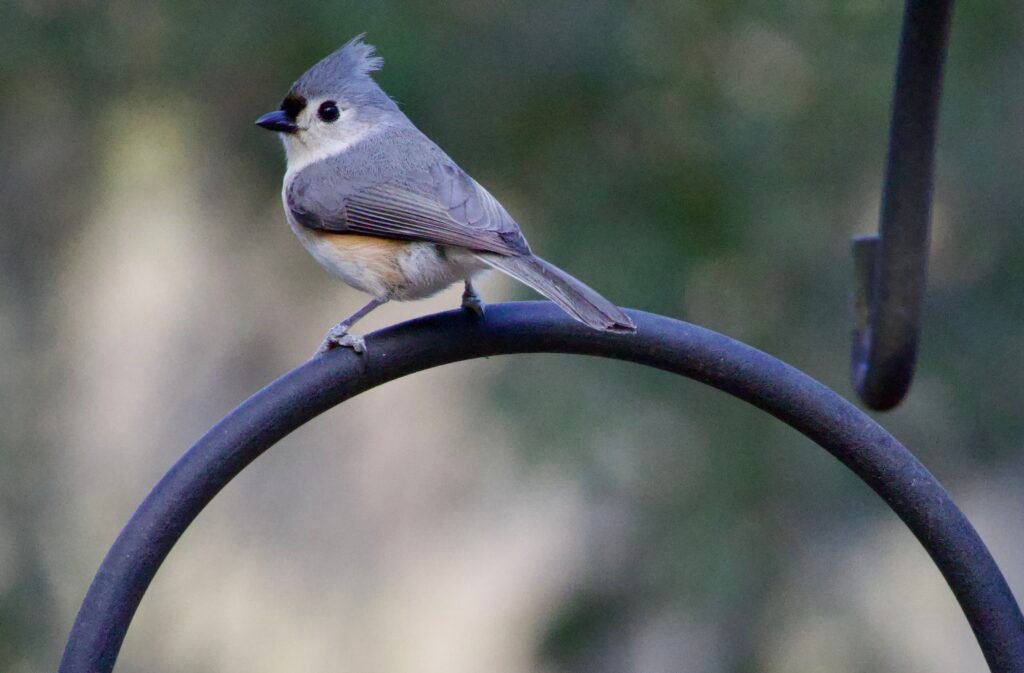
To clean feeders, first disassemble them if necessary. Then soak them in a diluted bleach solution (9 parts water to 1 part bleach) for about 15 minutes, especially if you suspect any of your birds are ill or your feeders are prone to growing mold. Next use a brush to scrub the feeder with dish soap and water. After a final rinse with water, reassemble your feeders and make sure they are dry before refilling with seed. According to the experts, using bleach on your feeders is the most important step in decontaminating and cleaning your feeders, so if you’re strapped for time, skip the soap and water and not the bleach.
How to Hang Your Feeders?
Most people hang their feeders from either a tree branch or from a pole setup. I recommend using a pole setup for a number of reasons, the primary one being the ability to keep squirrels off your feeder. Squirrels will undertake death defying feats of climbing or jumping to reach a bird feeder. They will manage to shimmy down ropes, land flying leaps from towering branches, and outsmart the cleverest “squirrel proof” feeders to reach your seed. A pole setup in the right location and protected by the correct baffle will thwart them.
Another reason to use a pole mounted system is to allow for additional feeders to be hung from one pole. Bird feeders are a little like boats or shoes, it’s hard to find one perfect for every situation. The feeders I detail below are very versatile and a great place to start. More likely than not, once started, you will get hooked and end up with a feeder collection.
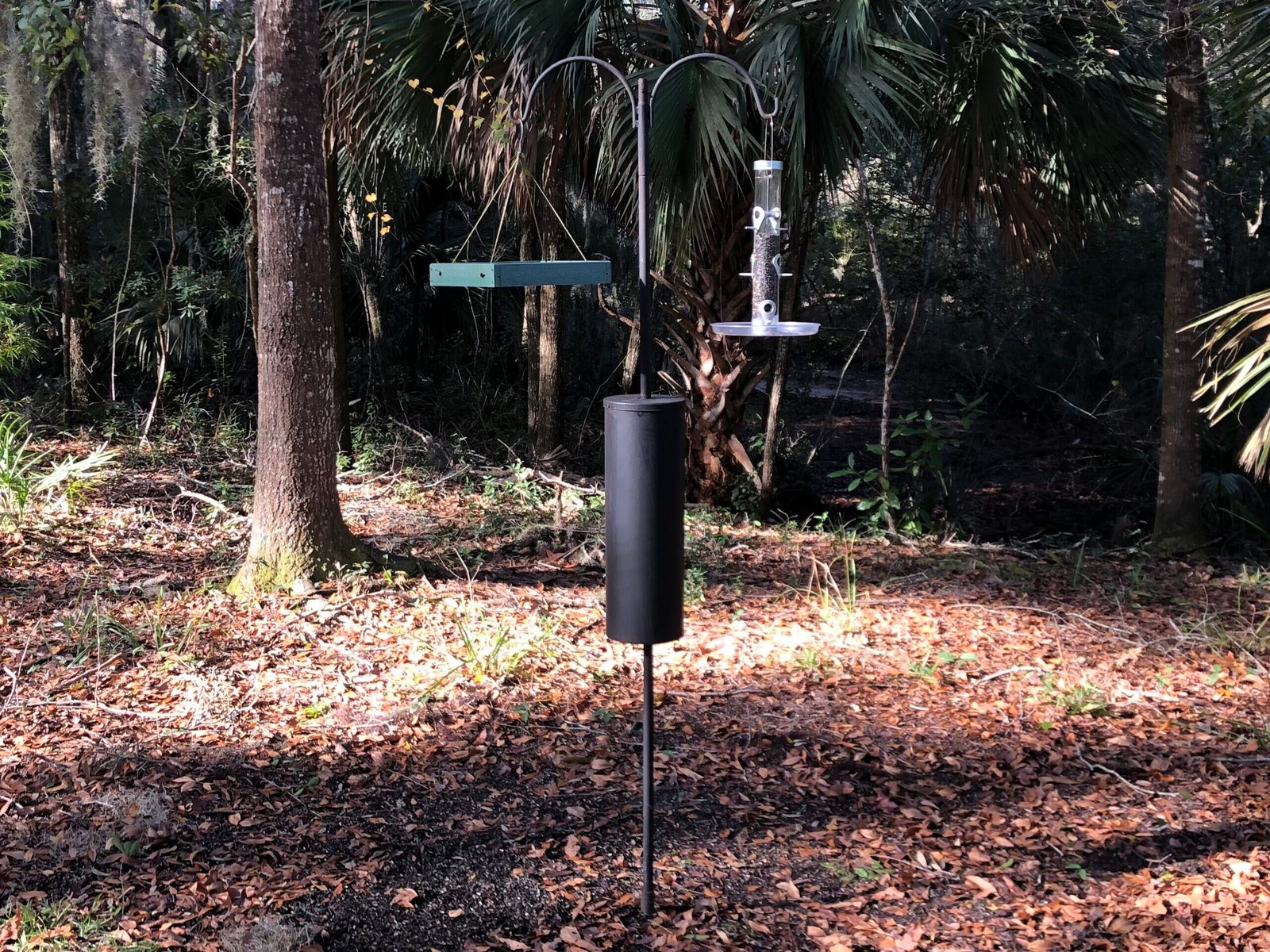
Pole Mounted Feeder System
I use and recommend the Advanced Pole System from Wild Birds Unlimited. The basic setup comes with a base you twist into the ground, a stabilizer to hold the pole straight in up to 35 mph winds, and two arms for hanging feeders. The system is customizable, so you can add additional arms and perches as your bird feeding enthusiasm grows. The poles are about an inch in diameter and black powder coated metal which while not rust proof, will last longer than any flimsy shepherd hook you’ll find at your local hardware store. My pole setup has made it through two hurricanes so far without damage or falling over. Duncraft sells similar pole systems, but I have not seen them in person. From their website, they appear to be a little less customizable in their design and accessories but will likely do the job.
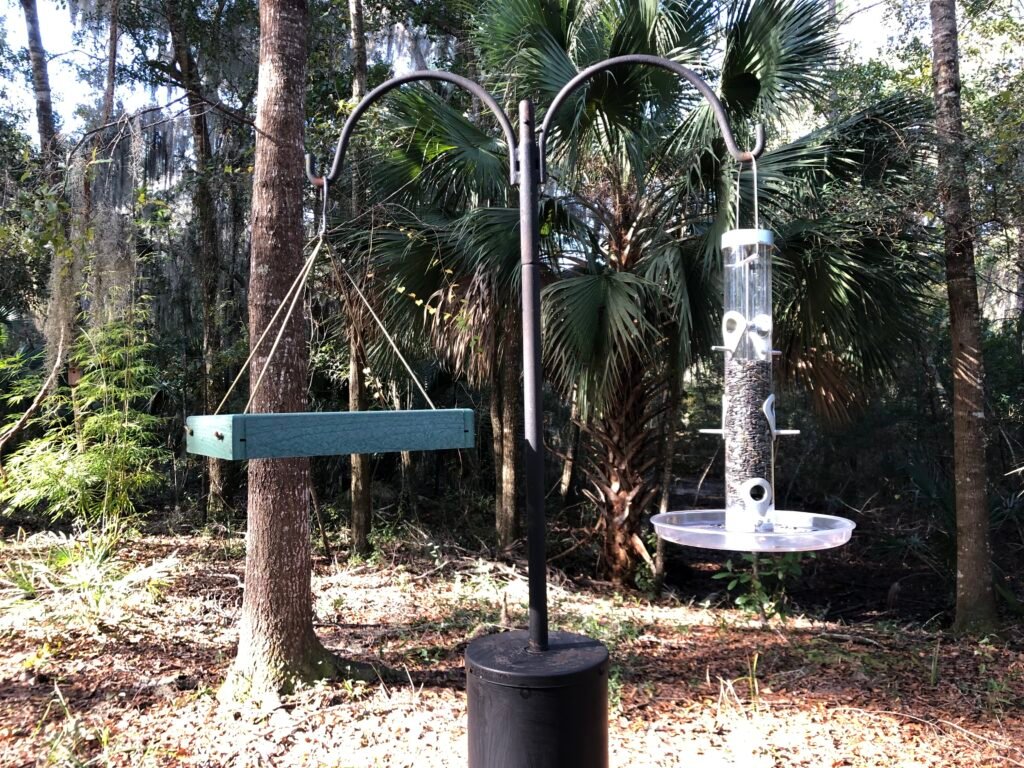
What is the Best Starter Bird Feeder?
As I mentioned above, there are a lot of bird feeder designs available out there. Some feeders are made to hold certain types of food, some are more decorative, some are colored to appeal to specific bird species, some are built to deter squirrels, and some are just bad. I have gone through a lot of bird feeders and there are two I would recommend you choose from as the first feeder to hang from your new pole system, platform and tube feeders. These feeders are great because they will hold a variety of seed, will appeal to a variety of different birds, are easy to clean, and should hold up well for many years of enjoyment. I also like platform and tube feeders for easy open viewing of multiple birds at one time.
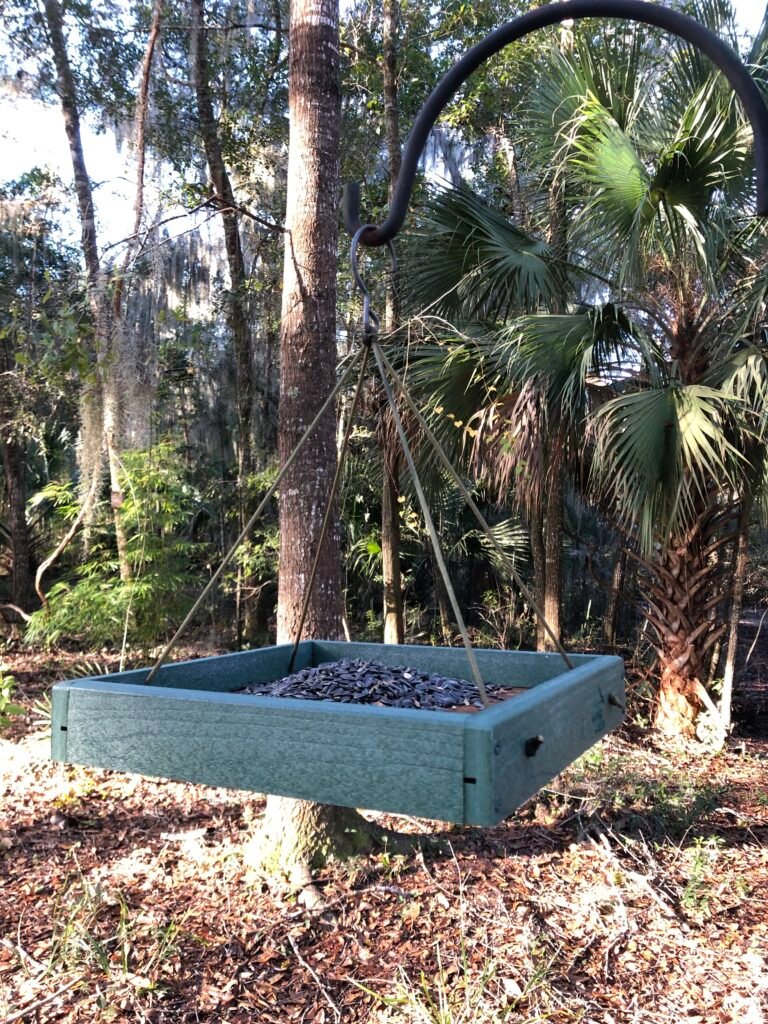
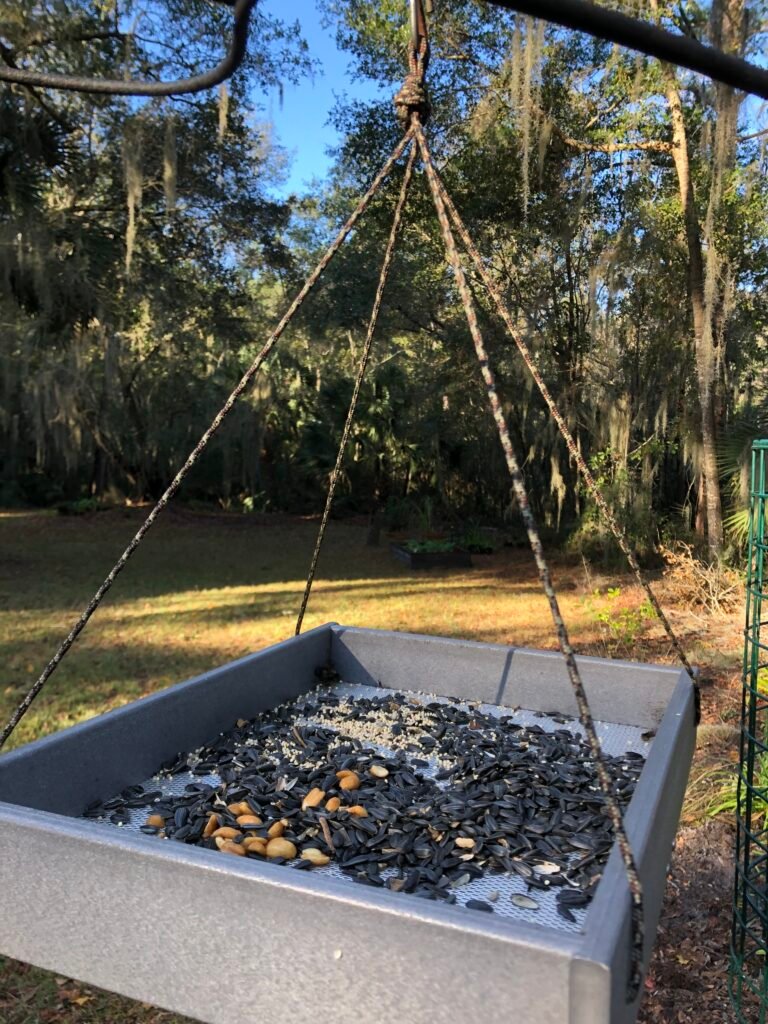
Platform Feeders
If I had to choose just one bird feeder to have in my yard it would be a large platform feeder. Platform feeders are accessible to just about any bird that will be looking for seed in your garden. Small perches may be difficult for your larger birds like Mourning Doves and Blue Jays to sit on, while your platform feeder will accommodate them as well as your smallest birds. Birds that prefer to feed on the ground, such as doves and sparrows will happily use a platform for feeding. Platform feeders also allow you to provide all sorts of food for your birds in addition to seed including fruit, mealworms, and suet.
Be sure to get a platform feeder that is made of plastic, not wood. A wooden feeder will disintegrate faster than you could imagine, especially if you live somewhere humid. They are also very difficult to keep clean. The bottom of the platform feeder should be mesh to allow for drainage and is best made out of metal. You will want a platform that is large enough for a few birds to access at once, otherwise you’ll find a single Mourning Dove will hog the entire thing.
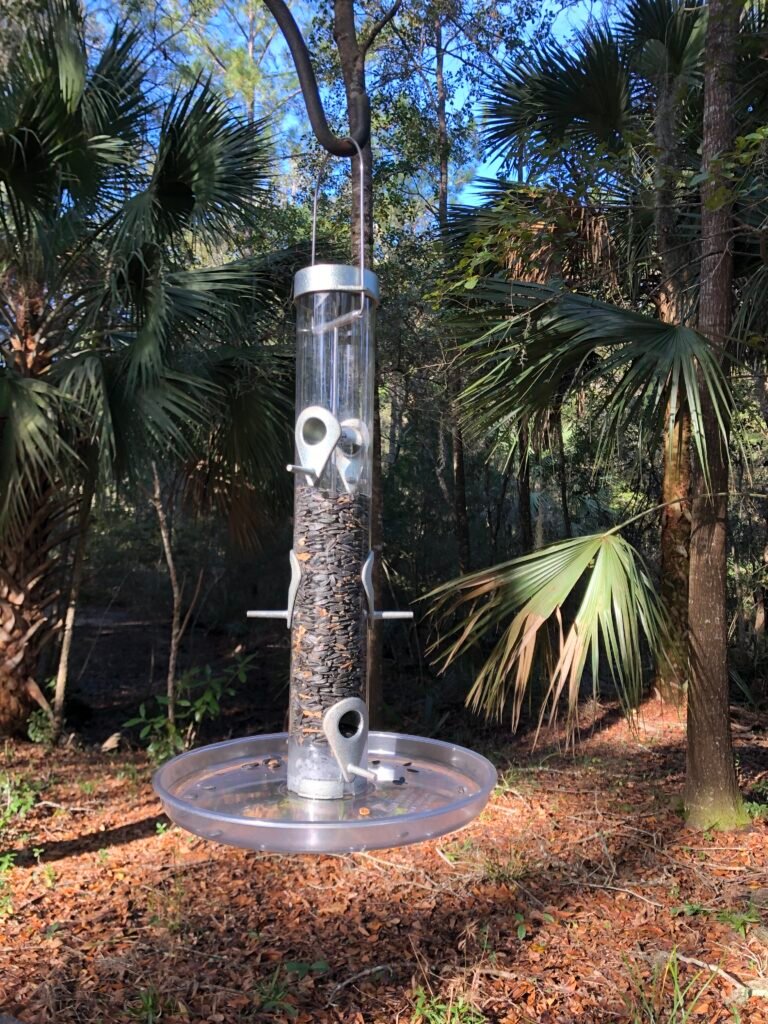
Tube Feeders
Tube feeders are exactly what they sound like, a durable plastic tube you fill with seed that has holes and perches to allow birds to access the seeds. They will protect your seed from rain better than open design feeders like platform and mesh feeders. Tube feeders come in all sorts of sizes with all kinds of bells and whistles, but all you really need is one that is large enough not to have to refill constantly and is easy to clean.
My favorite tube feeder is the Droll Yankees Ring Pull Tube Bird Feeder. It can hold up to a pound of seed, has durable metal parts in addition to the polycarbonate tube, is easy to fill, and is backed by Droll Yankees’ lifetime guarantee. In addition, the ring pull feature allows you to easily and quickly disassemble the feeder without tools. This feeder has a threaded base that will allow you to mount it on top of a pole if you so desire, or attach a seed tray, which I highly recommend. The little metal perches are readily used by smaller birds like chickadees, titmice and finches, but your larger birds will appreciate a tray to perch on to access the feeder.
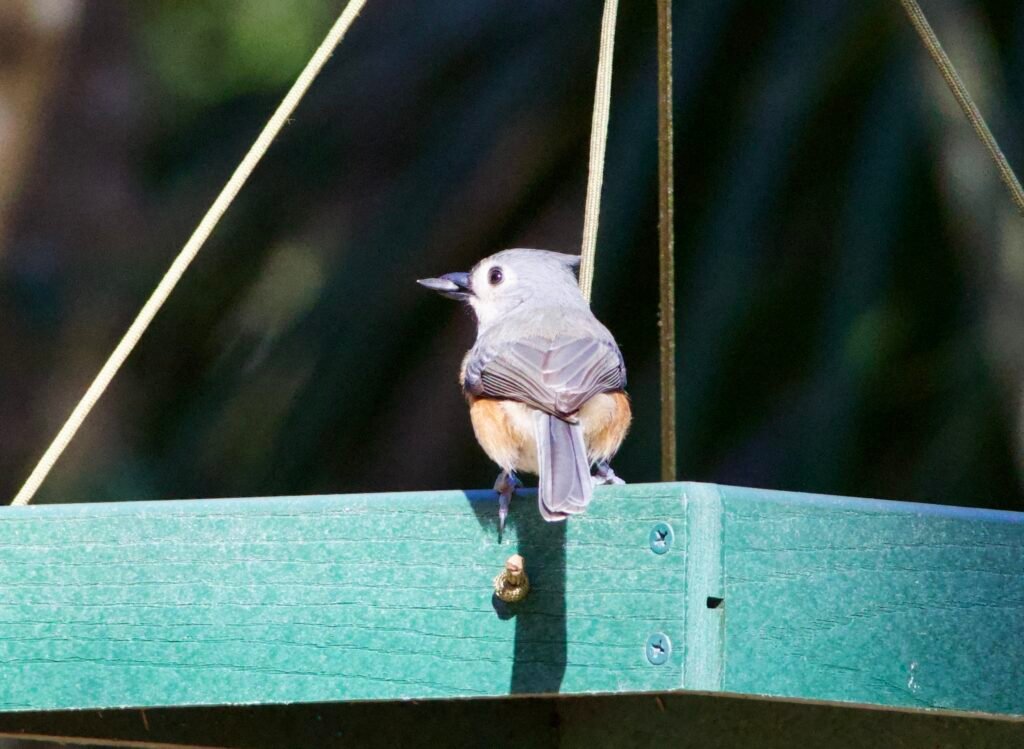
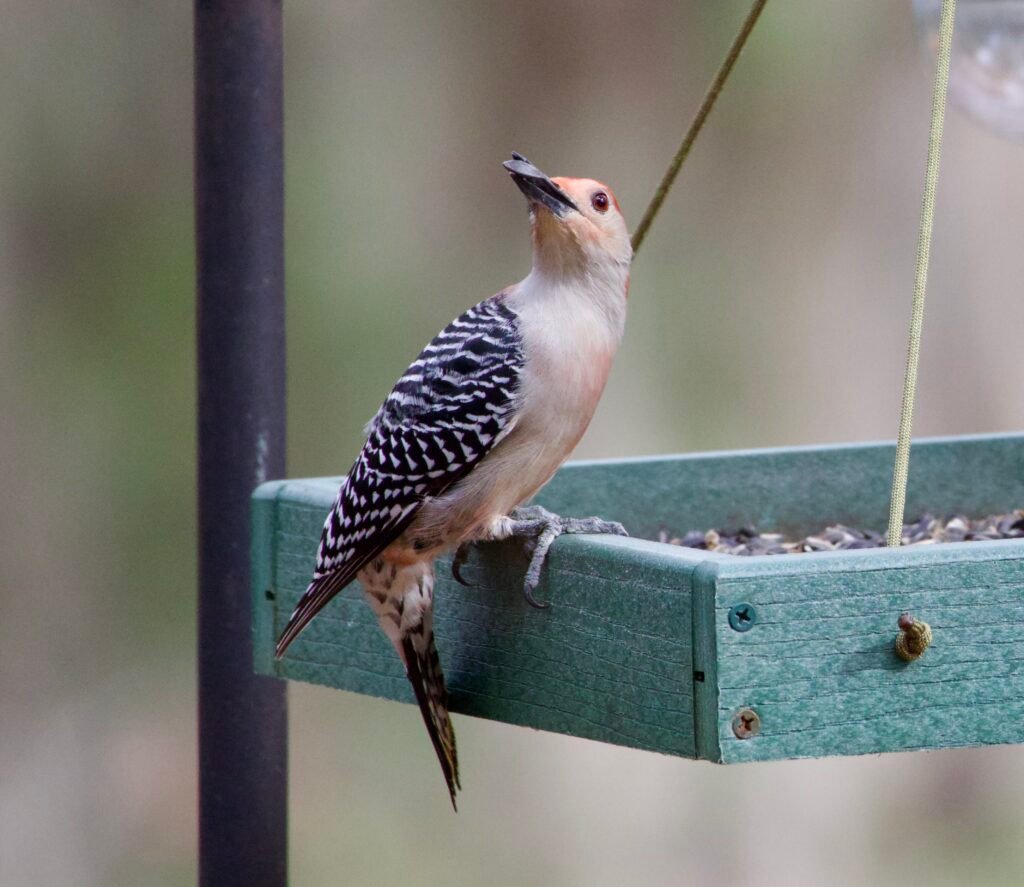
What is the Best Seed?
Bird seed isn’t cheap, so it’s important to purchase seed that will not go to waste. Many of bags of mixed wild bird seed contain filler seeds not particularly liked by most birds. Birds will dig through and fling out seed they find less desirable, which is why you might find later in your bird feeding journey that you have different feeders for different types of food. But that’s something to explore in a later post.
Black Oil Sunflower Seed
Black oil sunflower seed is the one seed type that will be eaten by the widest variety of birds in your garden. It is also the most affordable seed to start feeding your birds. Black oil sunflower seed is readily available at big box stores like Lowe’s and online, but I have found that Tractor Supply consistently has the cheapest black oil sunflower seed available. It may be worth looking at your local feed store to see what they have, sometimes their prices are very competitive and you can support a local business.
You will generally find whole black oil sunflower seed in stores. Most birds have no trouble removing the shells to access the meat of the seed inside. Birds will discard the shells under the feeder, which some folks might find a nuisance for a couple of reasons. First, the shells contain a toxin which will inhibit the growth of many plants including most grasses. Secondly, the shells will a pile up on the ground around your feeder which some folks might find unsightly. If these issues will be a problem for you, opt for shelled or chipped sunflower seeds. Shelled seed will be a little more expensive, but you will avoid killing your grass. Also, a wider variety of birds will eat shelled black oil seeds.
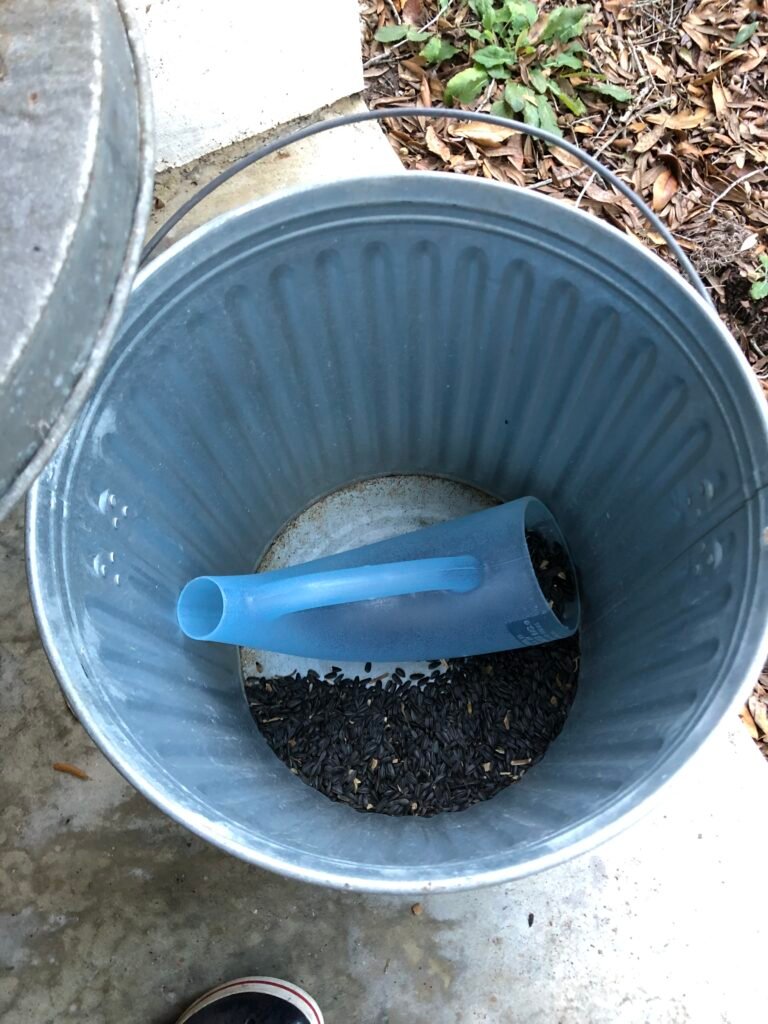
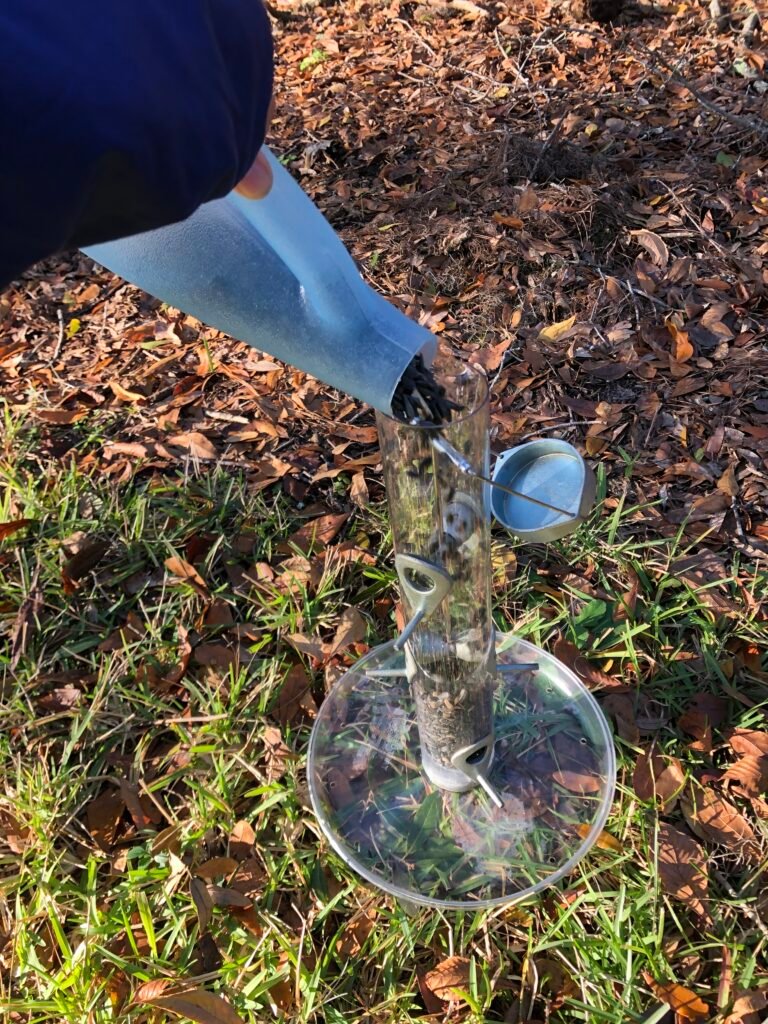
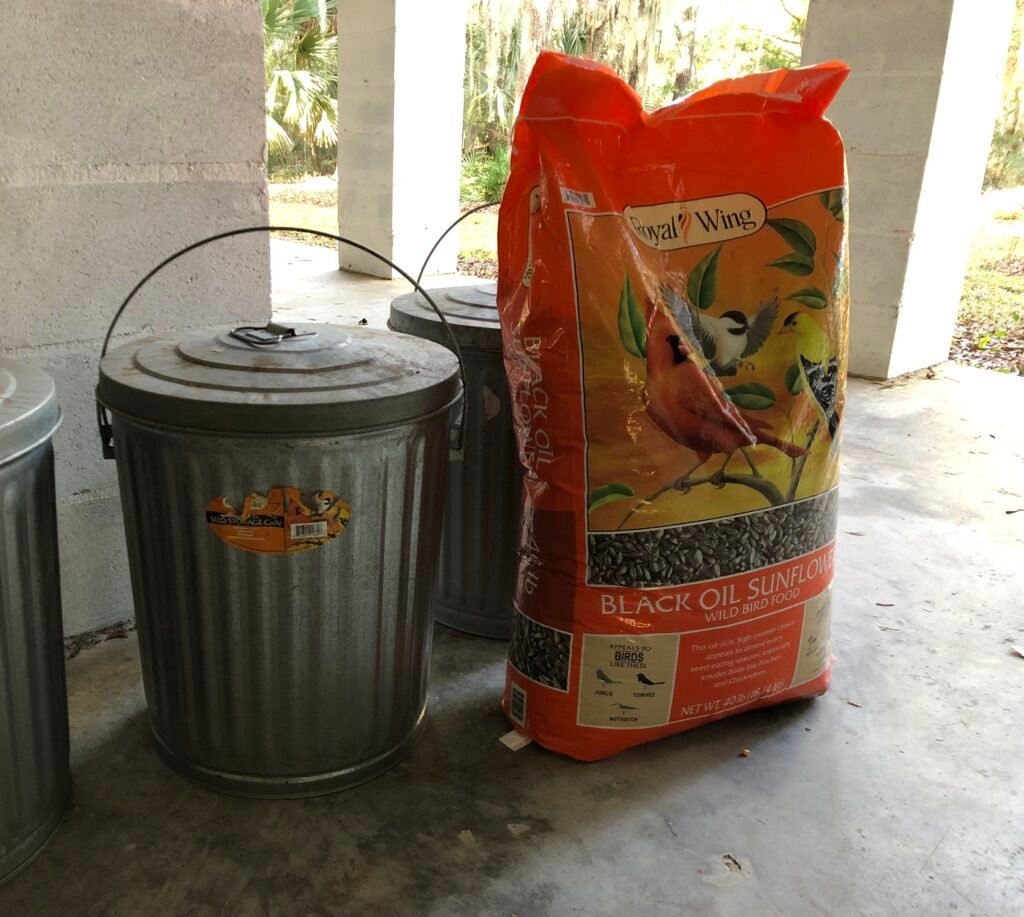
What is the Best Baffle?
For this pole system to be critter proof, you have to install a baffle. A baffle is simply an exclusion device, usually metal or plastic, that you attach to your feeder system to prevent unwanted animals access to your feeders. If you have squirrels, they will get onto your feeders if you do not have a baffle. And if you have raccoons in your area, you will want to install a baffle that is large enough to deter them too. If you already have problem raccoons that get into your stuff, you might consider going ahead and getting the largest baffle you can find. Generally, I’d recommend you plan for the worst when it comes to pests, so you don’t end up having spend twice as much to upgrade later.
I use an 8” raccoon baffle from Wild Birds Unlimited that fits on their ABS pole system. I have lots of large raccoons in my area, as well as a lot of gray squirrels and have yet to have a problem with either getting to my feeders. You’ll want to install the baffle so the top is at least 4 feet from the ground. At that height, raccoons should not be able to reach up over the top of the baffle to climb over it. Go with the 10” baffle if you know you have extra crafty raccoons in your area.
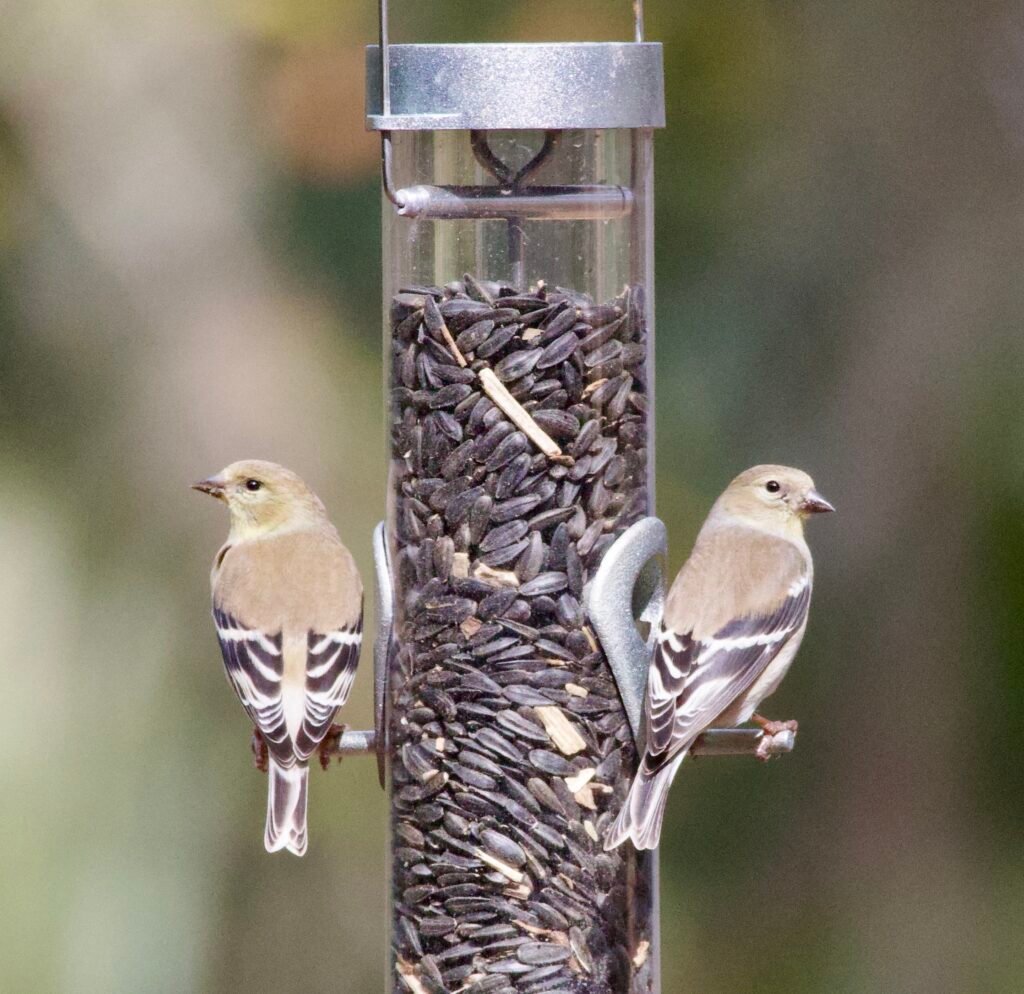
What Other Accessories?
It’s always more cost effective to purchase larger bags of seed. In order to keep your seed fresh and protect it from pests and critters, I’d recommend getting a container that will fit a 40 pound bag of seed and has a raccoon resistant lid. I use a 10 gallon metal can with a locking lid and once again, Tractor Supply has the best deal.
It’s also really nice to have a good scoop for dispensing seed. Droll Yankees makes a sweet plastic scoop that has a wide end for filling and a narrow end the perfect size to dispense seed into the opening of a tube feeder. Unfortunately, this scoop is now difficult to find. This scoop is a similar design and hopefully works as well as the Droll Yankees.
For cleaning, you’ll want a brush specifically made for cleaning tube feeders. If you stick with a platform feeder, any stiff plastic brush will do the trick.
Bigger is better when it comes to a seed tray for your tube feeder. I like the 10 inch trays from Droll Yankees for my ring pull tube feeders. Make sure any tray you get is compatible with your feeder and has drainage holes. Most trays attach using the threaded base at the bottom of the tube.
Finally, if you live somewhere especially rainy, you may want a rain guard to put over your feeders. A rain guard will protect your seed from getting wet and spoiling.
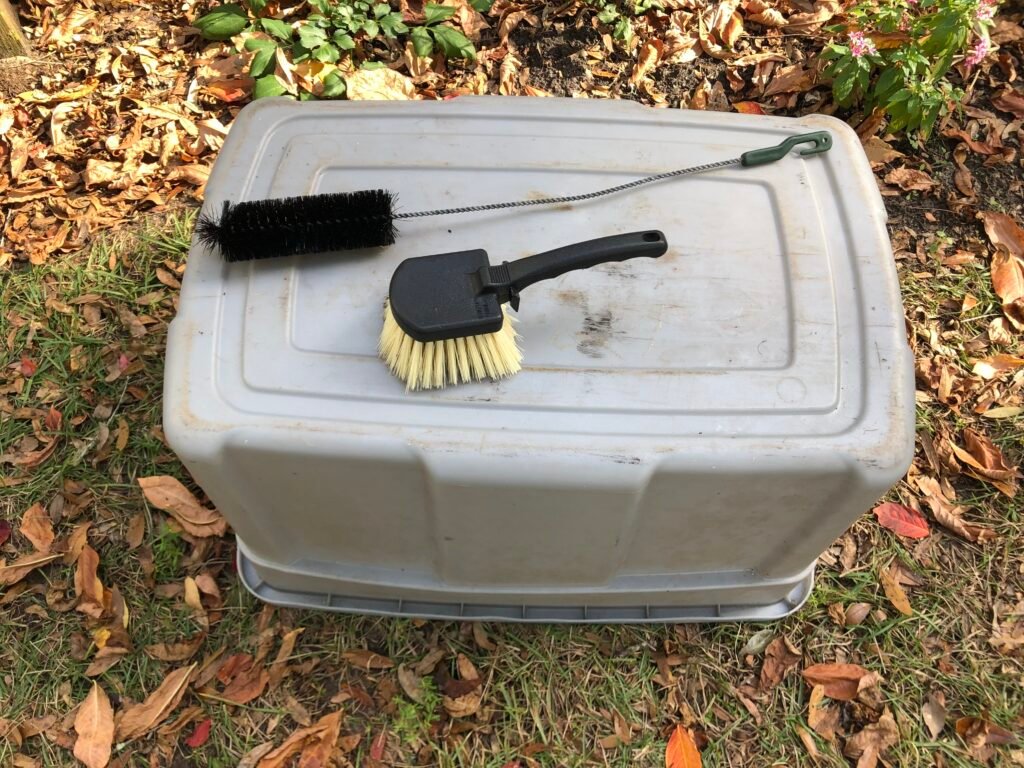
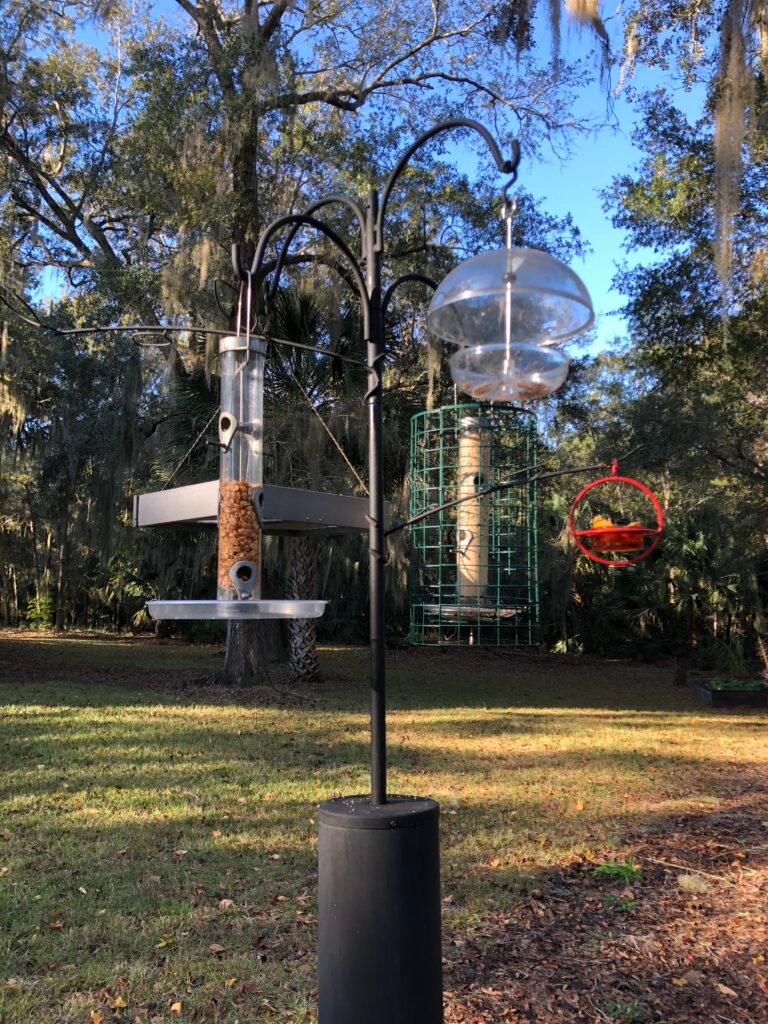
What to Expect?
It will likely take a few weeks for birds to find your new feeder set up. Don’t despair! They will find it eventually. I’d recommend only putting out a limited amount of seed at the start since you may have to replace it before it’s eaten if it gets wet.
Common Feeder Birds in the Southeast
- Northern Cardinals
- Carolina Chickadees
- House Finches
- Carolina Wrens
- Tufted Titmice
- Red-bellied Woodpeckers
- Hairy Woodpeckers
- Downy Woodpeckers
- Blue Jays
- White-breasted Nuthatches
- Brown-headed Cowbirds
- Common Grackles
- Mourning Doves
If you use chipped or shelled sunflower seeds in your feeders, you may also see Indigo and Painted Buntings, American Goldfinches, Pine Warblers, Ruby-crowned Kinglets, and Yellow-throated Warblers on your feeder.
In the Fall and Spring, you may be lucky to have some seed-eating migrants passing through your area find your feeder. One of the most glamorous is the Rose-breasted Grosbeak. Winter may also change the composition of your feeder birds, with Purple Finches, Ruby-crowned Kinglets and American Goldfinches moving father south and showing up at your feeders, while some of your summer birds like Blue Jays rarely visit anymore and your tropical migrants like Painted Buntings have left for their winter homes further south.


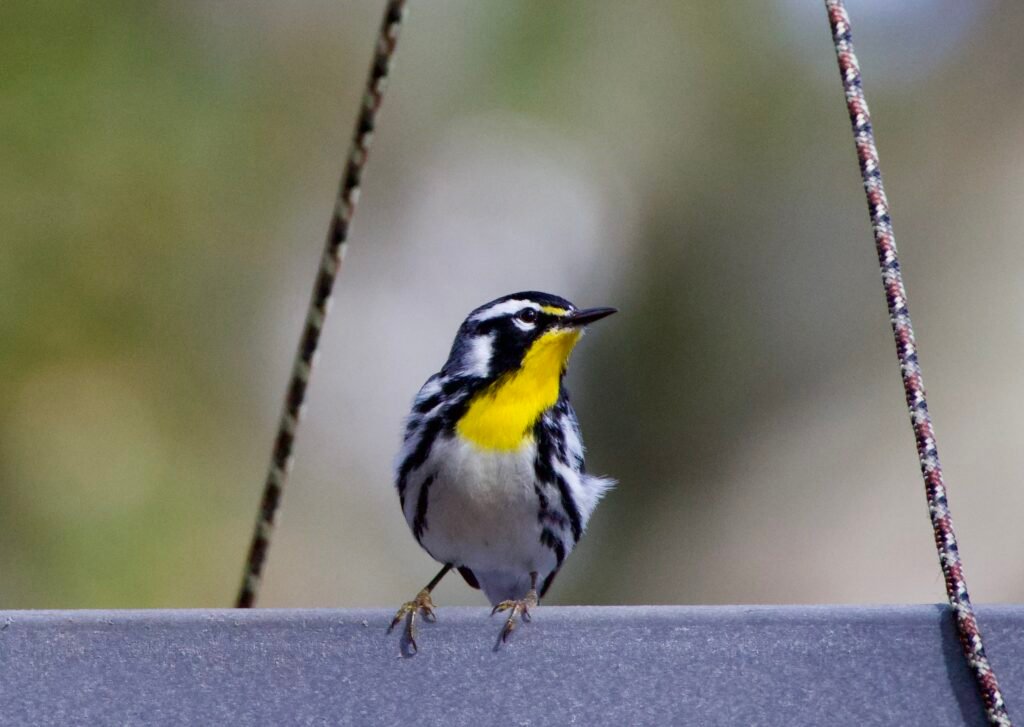
Project FeederWatch has a cool online tool that can help you determine the common feeder birds in your area and their food preferences. Also consider how to attract more birds by improving habitat in your garden. Native plants provide food, shelter, and nesting structure for birds.
While building this feeder setup may seem like a big investment, if you follow these recommendations, you will be less likely to feel the need to replace equipment later. Start with the best bird feeders, and you will be able to spend your time enjoying the birds rather than trouble shooting your setup. When you do get the itch to incorporate more feeders and food options for your birds, check back in here! I’ll be posting articles about advanced feeder setups like offering mealworms.
Want to Learn More?
- Nature 2022: Smartphone-based ecological momentary assessment reveals mental health benefits of birdlife by Hammoud, Tognin, Burgess, Bergius, Smythe, Gibbons, Davidson, Afifi, Bakelite, and Mechilli
- PLOS ONE 2016: Urban Bird Feeding: Connecting People with Nature by Cox and Gaston
- Ecological Economics 2021: Birds of a feather lockdown together: Mutual bird-human benefits during a global pandemic by Brock, Doremus and Li
- Conservation Biology 2011: Relations between Urban Bird and Plant Communities and Human Well-Being and Connection to Nature by Luckm Davidson, Boxall, and Smallbone
- Conservation Physiology 2015: Effects of bird-feeding activities on the health of wild birds by Wilcoxen, Horn, Hogan, Hubble, Huber, Flamm, Knott, Lundstrom, Salik, Wassenhove, and Wrobel
- All About Birds 2018: Why Do We Feed Birds – And Should We? A Q&A with the Experts by Leonard and Fiorino
- Science 2019: Decline of the North American avifauna by Rosenberg, Dokter, Blanche, Sauer, Smith, Smith, Stanton, Punjabi, Helft, Parr, and Marra
- All About Birds 2023: Three Years After 3 Billion Birds Lost, America’s Birds are Still in Decline by Ramanujan
- Naturwissenschaften 2018: Insectivorous birds consume an estimated 400–500 million tons of prey annually by Nyffeler, Şekercioğlu, and Whelan
- Ornithological Applications 2021: Are declines in insects and insectivorous birds related? by Tallamy and Shriver
- Crop Protection 2023: The predation impact of ruby-throated hummingbird, Archilochus colubris, on spotted-wing drosophila, Drosophila suzukii, in raspberry, Rubus idaeus by Carroll, Marshall, Mattoon, Weber, and Loeb
- The Condor 2014. Bird–building collisions in the United States: Estimates of annual mortality and species vulnerability by Loss, Will, Loss, and Marra
- Nature Communications 2013: The impact of free-ranging domestic cats on wildlife of the United States by Loss, Will, and Marra
- Audubon 2016: Think you have a bird-friendly backyard? Think again by Waters
- Audubon2016: Why Native Plants are Better for Birds and People by Richie

This is super helpful! Great post. Especially the section about which seed to put out. How do I keep the Stellar Jay’s from hogging my feeder? They are kind of bullies and push out the smaller birds.
Thanks Jennifer!
The only way to keep the larger birds from your feeder is to have a feeder just dedicate to your small birds that has a exclusion device installed. I’ve accomplished this by placing a wire cage around one of my tube feeders. The mesh of the cage is small enough to keep out the jays and other large birds while allowing the sparrows and chickadees and finches access. You can also buy feeders made for small birds with the cage attached, although I like to use my favorite easy to clean ring pull feeders and just add the cage. I purchased mine from Wild Birds Unlimited but Duncraft and the Audubon store also have some options. Be sure to note the size of the cage so it fits over your feeder as well as the mesh size.
This is a terrific article that provides the information to set up and maintain a year round successful bird feeding station. The pleasure I derive from attracting and viewing birds in my garden is money well spent. I agree that investing in a quality and expandable feeding system saves money in the long run. Also, buying cheap, poor quality food will reduce your ability to attract birds; buying good quality food will enhance your bird watching experience!
Pingback: The Southern Wild - Raising Mealworms for Wild Birds
Pingback: The Southern Wild - How to Attract Ruby-crowned Kinglets
Pingback: The Southern Wild - Grow Frostweed in Your Native Plant Garden